We recently tested three single-action traditional-style revolvers in the popular 38 Special/357 Magnum chambering to find which revolver would be best for Cowboy Action Shooting. We also considered the merits of each as a trail gun. While some may scoff, there are many single-action revolvers in use for home protection, including protecting the homestead against predators, so we had to consider this role as well. The three revolvers were from Traditions Performance Firearms: the Sheriff’s Model, the Liberty Model, and the Frontier Model. The qualifying difference between the three revolvers are their barrel lengths, though in this test, they are vastly different overall. The longer the barrel, the greater the weight of the revolver as well. The barrels were 3.5, 4.75, and 5.5 inches long. While we liked the 5.5-inch barrel the best based on balance, point, and fast-paced accuracy, the gun itself was the roughest revolver tested as far as the trigger action went and the only one that gave trouble. It wasn’t difficult to get it up and running, but this just isn’t welcome in a new revolver. On the other hand, the Sheriff’s Model was a fun gun to shoot, but not the most practical. We cannot recommend it for CAS competition, but it makes a good recreational handgun and perhaps even a personal-defense revolver for those skilled with the single action. The 4.75-inch-barrel Liberty revolver was the most accurate revolver and was well finished with beautiful laser engraving. It was more accurate than the longer-barrel revolver from the benchrest but not as easy to get a fast hit with on the action course.
When you choose a single-action revolver for Cowboy Action Shooting, a sense of style and history are important. Reliability and good value are also important. When considering the single-action revolver, the 7.5-inch barrel length is regarded as too large and heavy by most shooters. A shorter-statured shooter may find the muzzle in his boot tops in a conventional holster. The fit, finish, and barrel length and balance, then, are important. For recreational use, one may be as good as the other. The greatest accuracy, velocity and handling advantages are more important in a handgun to be used in CAS competition. Considerations other than accuracy, such as heft and fast handling, are important. The speed of the draw is important. The so-called Tall Draw with a long-barrel revolver isn’t as fast as with the shorter handguns. This fact gave birth to the original SAA that came to be known as the Gunfighter’s barrel length. The barrel was cut right to the ejector rod, and this resulted in a 4.75-inch-barrel revolver. The compromise 5.5-inch barrel length was often called the Artillery revolver and issued to cannoneers. The short 3-inch-barrel revolver was called the shopkeep’s or, more popularly, the Sheriff’s Model. We tested all three to determine which has an advantage.
Range Data
| Handload: Titegroup Powder Magnus 200-gr. RNL | Sheriff’s Model (3.5-in. barrel) | Liberty Model (4.75-in. barrel) | Frontier Model (5.5-in. barrel) |
| Average velocity | 700 fps | 720 fps | 715 fps |
| Muzzle energy | 217 ft.-lbs. | 230 ft.-lbs. | 226 ft.-lbs. |
| Average group size | 2.4 in. | 1.8 in. | 2.6 in. |
| Black Hills 357 Magnum158-gr.CowboyLoad | |||
| Average velocity | 799 fps | 805 fps | 824 fps |
| Muzzle energy | 223 ft.-lbs. | 227 ft.-lbs. | 238 ft.-lbs. |
| Average group size | 2.8 in. | 1.75 in. | 2.4 in. |
| Federal 357Magnum125-gr.JHP | |||
| Average velocity | 1370 fps | 1442 fps | 1480 fps |
| Muzzle energy | 520 ft.-lbs. | 577 ft.-lbs. | 607 ft.-lbs. |
| Average group size | 2.75 in. | 1.75 in. | 2.4 in. |
| To collect accuracy data, we fired five-shot groups from a solid benchrest. Distance: 7 yards. We recorded velocity with a Shooting Chrony Master Chronograph. The first sky screen was 10 feet from the muzzle. | |||
The caliber wasn’t difficult to choose. While the 45 Colt, 44-40 and 38-40 may be more authentic to the time period, the 38 Special is the superior cartridge for competition today, we believe. The larger calibers are sometimes smoky when downloaded. The 38 Special responds well with Cowboy Action loads. If you desire, the 357 Magnum cartridge may be loaded for use as a trail gun or as a defensive handgun. Anyone who uses the SAA revolver well in CAS competition would be a formidable opponent in a home-defense situation.
For ammunition, we chose three loads, one in 38 Special and two in 357 Magnum. We used a handload consisting of the Magnus cast bullets 200-grain RNL ($49.10 for 500 bullets from MagnusBullets.com) and enough Titegroup powder for 720 fps. This is an outstanding load with plenty of bearing surface for accuracy. It hits the steel plates hard. Next, we used the Black Hills Ammunition 357 Magnum 158-grain cowboy load ($30.30/50 rounds from AmmunitionToGo.com). Loaded to 805 fps on average, this load offers the ease of loading of the full-length Magnum case but is loaded to 38 Special velocity. Finally, we used the Federal 125-grain JHP as a general-purpose 357 Magnum load to determine how the pistols perform with Magnum loads. It costs $21.30/20 rounds. While Cowboy Action guns are seldom fired with full-power ammunition, for Gun Tests, Magnum loads were an important part of the evaluation equation.
Traditions 1873 Sheriff’s Model SAT73-005 357 Magnum, $410
GUN TESTS GRADE: B
No kidding about this one; we really like the looks. The revolver works well, with a smooth action. We consider smoothness of cocking and loading as well as the trigger action when we say smoothness, and this revolver has that. The shorter barrel, however, limited its performance in all regards, including accuracy, energy, and a full powder burn.
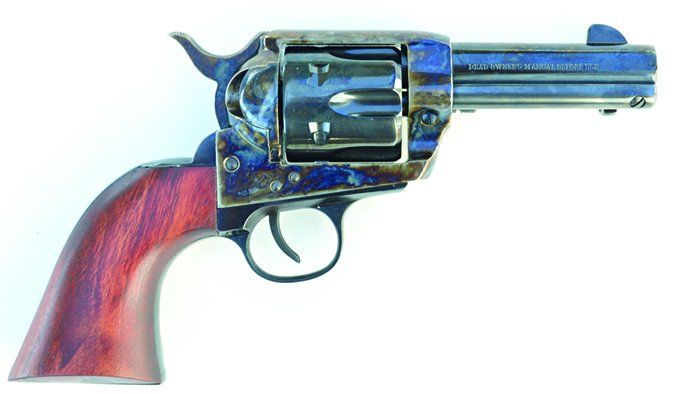
| TYPE | Single-action revolver |
| CAPACITY | 6 |
| WEIGHT UNLOADED | 38.4 oz. |
| WEIGHT LOADED | 40.1 oz. |
| OVERALL LENGTH | 9 in. |
| BARREL LENGTH | 3.5 in. |
| SIGHT RADIUS | 4.5 in. |
| OVERALL HEIGHT | 5.1 in. |
| FRONT STRAP HEIGHT | 2.1 in. |
| BACK STRAP HEIGHT | 3.4 in. |
| MAX WIDTH | 1.7 in. |
| GRIP THICKNESS (max) | 1.4 in. |
| GRIP CIRCUMFERENCE (max) | 4.1 in. |
| FRAME | Case-hardened-finish steel |
| BARREL | Blued steel |
| GRIP MATERIAL | Wood |
| TRIGGER PULL (SA) | 3.5 lbs. |
| TRIGGER SPAN (SA) | 2.9 in. |
| TELEPHONE | (860) 388-4656 |
| WEBSITE | TraditionsFirearms.com |
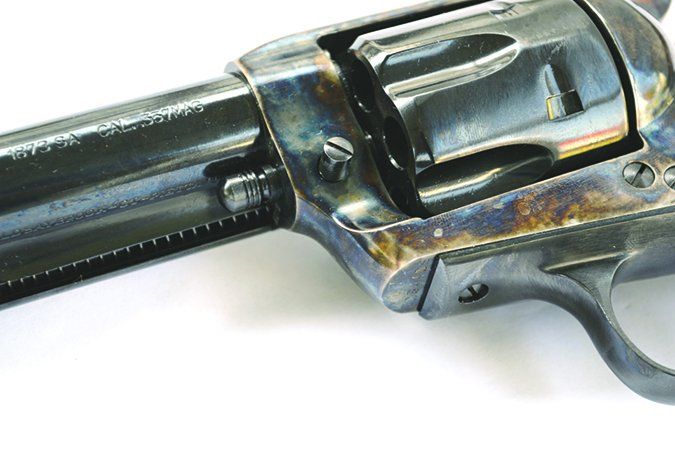
The Traditions Sheriff’s Model is the personal gun of one of our raters. He had wanted a short SAA, he said, for more than a decade. This revolver is affordable. The fit and finish are good. The case-hardened frame and blued barrel, cylinder, and grip strap are well done. The sights are typical of modern SAA clones, a little better than the original SAA revolvers because the sight notch is wider and the front sight more likely to be properly regulated. The trigger action is particularly good at a crisp 3.5 pounds. Like the other two revolvers, this piece features a transfer-bar ignition system. The original SAA and some modern clones used a firing pin in the hammer. Such revolvers demand the chamber below the hammer is kept empty.
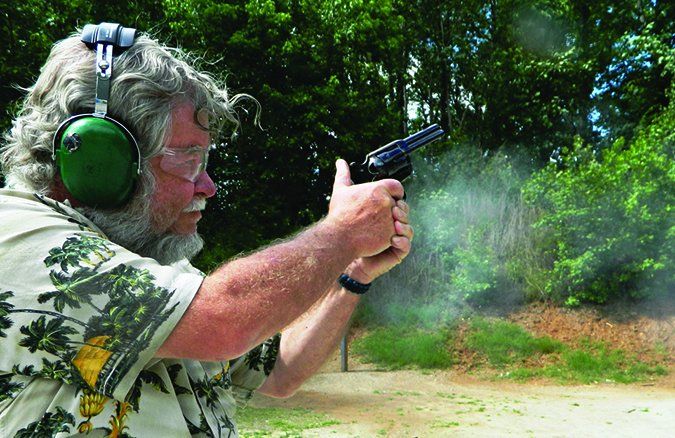
The modern transfer-bar system allows carrying six rounds safely. Just the same, many still load only five beans under the wheel. For safety, we also loaded the Pietta revolvers with only five rounds. We loaded one cartridge, skipped a chamber, loaded four and then cocked the hammer to lower it on an empty chamber. While the Pietta revolver uses a transfer bar design, it loads in the traditional manner. The hammer is placed at half cock and the loading gate opened. (Ruger revolvers also feature a transfer-bar system but load with the hammer down.) Cartridges are loaded and the cylinder rotated to load each chamber.
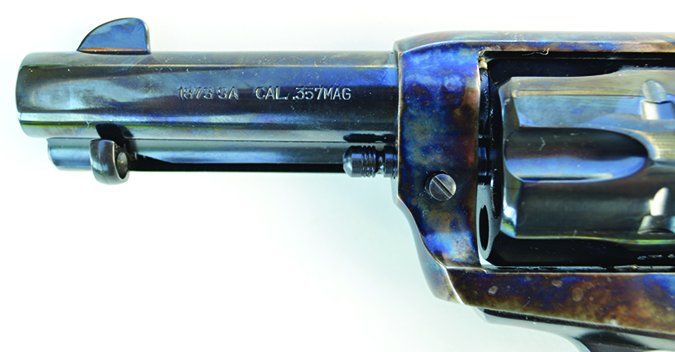
The fit of the cylinder and the backstrap to the frame are good, as were cocking action and rotation of the cylinder. The grip isn’t quite the same as the original SAA; it is a little larger and we like that. The defining feature of this revolver is the 3.5-inch barrel. We like the balance, although it is a little handle heavy. Unlike the original Sheriff’s Model, this revolver features a functioning ejector rod. We feel that’s why the Pietta-made revolver features a 3.5- rather than a 3-inch barrel, so as to provide workable ejection. The short ejector rod actually works and ejects the cases just fine with the muzzle pointed upward. We fired the revolver at man-sized targets at 7, 10, and 15 yards, firing 25 rounds each of the 200-grain handload and the Black Hills Ammunition 158-grain cowboy load. Results were good. The Sheriff’s Model is a lot of fun to shoot, no question about that, and it is accurate enough. The cartridges ejected fine without excess-pressure signs. The revolver is as fast on target as the other two cowboy guns, but it is not as fast to an accurate follow-up hit, we found. The short sight radius demands a little more time to line up. The Sheriff’s Model was accurate enough at this range, and sight regulation was dead on with the 158-grain load and a little high with the 200-grain handload. The pistol is fast from leather but just doesn’t balance as well as the heavier longer-barrel handguns.
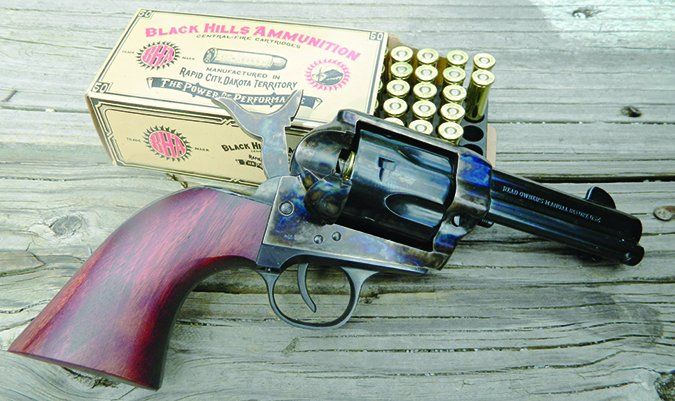
When working from the benchrest to fire for accuracy, we found the Sheriff’s Model is an accurate handgun. Taking time to line the sights properly demanded more time than the other revolvers, however. Another drawback is muzzle blast. Firing from the benchrest position, we felt the muzzle blast across our face when firing the full-power Magnum cartridge. All short-barrel 357 Magnum revolvers demonstrate this trait. Accuracy was good, with two of the three loads exhibiting five-shot groups of 2 inches or less. The Magnum load opened up a little, but we feel that recoil and blast had much to do with this.
Our Team Said: In the end, we don’t feel that this is a viable revolver for CAS shooting. The balance just isn’t as good as the longer-barrel revolvers. It isn’t appreciably faster on the draw than the 4.75-inch-barrel handgun, and the natural point isn’t that good. However, this is one neat-looking revolver with an attractive appearance. For recreational shooting or even home defense, it is not a bad choice among single-action revolvers.
Traditions 1873 Liberty Model SAT73-119LIB 357 Magnum, $550
GUN TESTS GRADE: A (Best Buy)
The fit and finish were nice, and we really like the laser engraving. A combination of accuracy and good handling make it the best buy of the test. As a cowboy gun, there were no drawbacks. The 4.75-inch barrel seems the best compromise for overall handling.
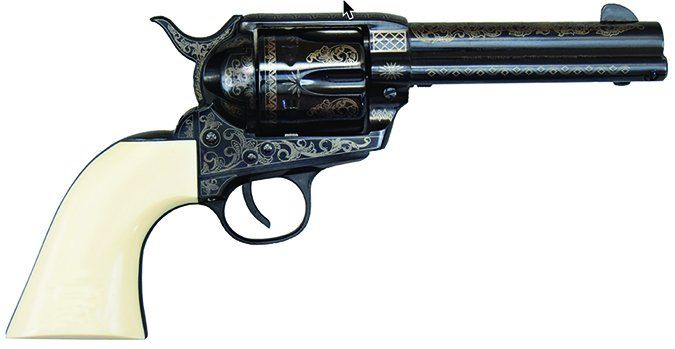
| TYPE | Single-action revolver |
| CAPACITY | 6 |
| WEIGHT UNLOADED | 39.5 oz. |
| WEIGHT LOADED | 42 oz. |
| OVERALL LENGTH | 10.25 in. |
| BARREL LENGTH | 4.75 in. |
| SIGHT RADIUS | 5.75 in. |
| OVERALL HEIGHT | 5.1 in. |
| FRONT STRAP HEIGHT | 2.1 in. |
| BACK STRAP HEIGHT | 3.4 in. |
| MAX WIDTH | 1.7 in. |
| GRIP THICKNESS (max) | 1.4 in. |
| GRIP CIRCUMFERENCE (max) | 4.1 in. |
| FRAME | Nickel-finished steel |
| BARREL | Nickel-finished steel |
| GRIP MATERIAL | White plastic |
| TRIGGER PULL (SA) | 4.5 lbs. |
| TRIGGER SPAN (SA) | 2.9 in. |
| TELEPHONE | (860) 388-4656 |
| WEBSITE | TraditionsFirearms.com |
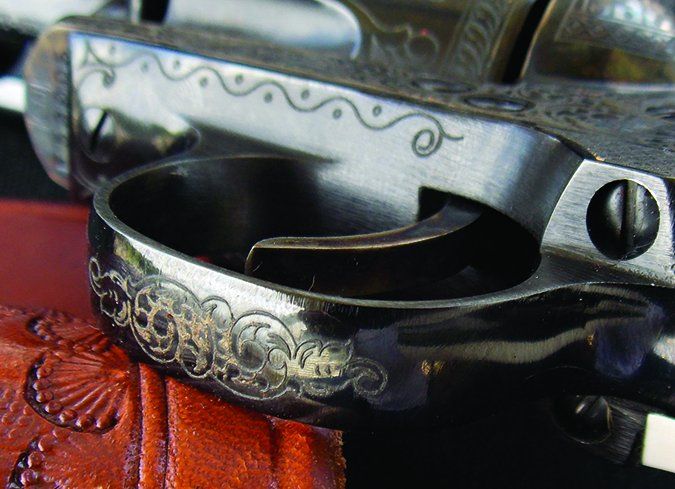
The Liberty is very nicely finished in a bright blue that is both deep and dark. The grips are white of a plastic-like material. There is a very slight overhang on the front strap from the grips that could be filed easily. The extra $142 over the Sheriff’s Model is worthwhile if you like the pistol’s laser engraving. We are not experts on bank-note or leaf-style engraving, but we know what we like. A few years ago Pietta contracted with a company in Italy to perfect a specific type of machinery to laser-engrave revolvers. The result is affordable high-quality engraving a few steps above etching. The result is very well done. (A nick in the engraving wasn’t a factory defect, it was from the owner’s weekly use of the revolver.) The Liberty features a 4.75-inch barrel. This was the original Gunfighters barrel length. It was practically as fast from the Rocking K belt slide or the Lobo Gunleather pancake during the evaluation as the Sheriff’s Model and much better balanced. When going for fast work on targets at close range, the 4.75-inch barrel was very fast. Recoil with the handload and the Black Hills 158-grain 357 Magnum Cowboy load was modest. However, we found the 5.5-inch barrel length is faster for repeat shots.
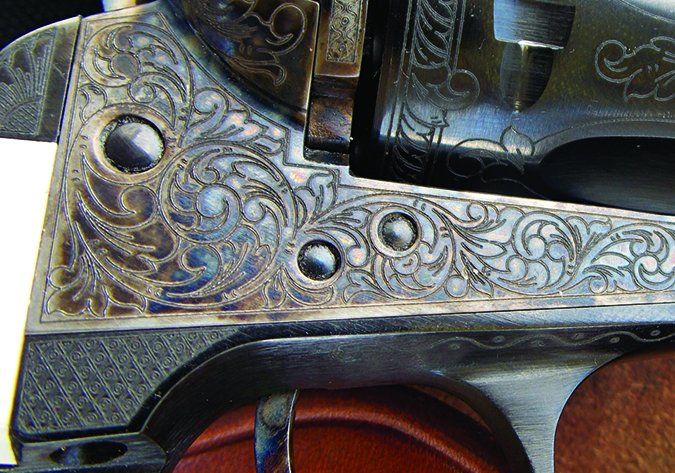
Firing from the bench, the 4.75-inch-barrel Pietta revolver was the most accurate handgun tested. Some groups were less than 1.5 inches at 25 yards. Muzzle blast was much less offensive than with the 3.5-inch-barrel Sheriff’s revolver. The sensation is more pleasant than with a 4-inch-barrel double-action revolver as well. The plow-handled grip is well known for absorbing heavy recoil. The single-action revolver isn’t as fast in a combat course or as fast to load as a double-action revolver — of course not — but it can be at least as accurate and it is more comfortable to fire. With the Federal 357 Magnum cartridge, the Liberty was comfortable to use and fire. We carried the Liberty in a number of holsters, from the Rocking K belt slide to a well-done recreation of the original Old West spring-loaded shoulder holster by the same maker. This side test of holsters demonstrated that the 4.75-inch barrel length is the handiest for carry, whether in the field or just for the fun of carrying a single action.
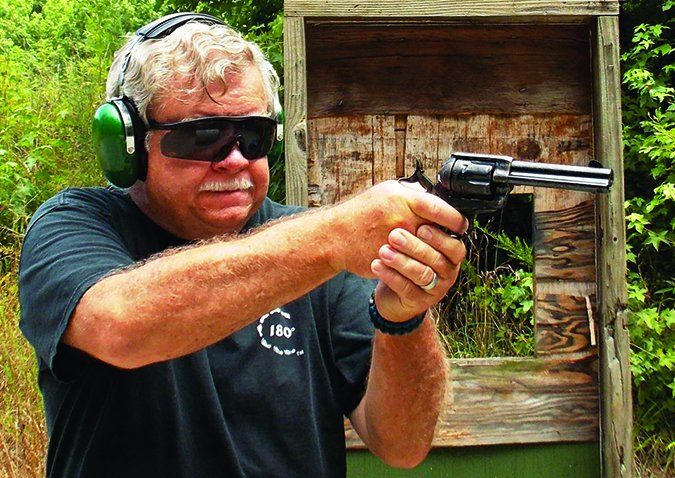
Likewise, the Liberty was the most accurate revolver from the bench, despite the limitation of a smooth, but heavy, trigger action at 4.5 pounds. The break, however, was clean. As the test results show, sometimes a heavier comparative trigger action is not that great an impediment, at least in trigger actions below 5 pounds.
Our Team Said: For practical use, from Cowboy Action Shooting to personal defense and recreational shooting or trail use, the Liberty is our choice and the only “A”-rated gun in the test.
Traditions Frontier Series 1873 Barrel Nickel/White PVC SAT73-126 357 Magnum, $550
GUN TESTS GRADE: B-
We really like the handling of this revolver. While the majority of the raters liked the appearance of the Liberty best, a couple who examined the Frontier revolver liked the nickel-plated revolver better. For a revolver destined for CAS shooting, we want a reliable handgun, but it isn’t as critical as a personal-defense revolver. We feel that the Frontier revolver must have had a burr in the action of some sort that caused a function problem.
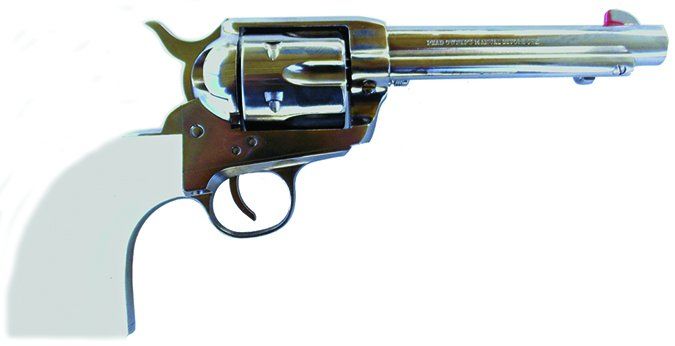
| TYPE | Single-action revolver |
| CAPACITY | 6 |
| WEIGHT UNLOADED | 41 oz. |
| WEIGHT LOADED | 43 oz. |
| OVERALL LENGTH | 11 in. |
| BARREL LENGTH | 5.5 in. |
| SIGHT RADIUS | 6.5 in. |
| OVERALL HEIGHT | 5.1 in. |
| FRONT STRAP HEIGHT | 2.1 in. |
| BACK STRAP HEIGHT | 3.4 in. |
| MAX WIDTH | 1.7 in. |
| GRIP THICKNESS (max) | 1.4 in. |
| GRIP CIRCUMFERENCE (max) | 4.1 in. |
| FRAME | Nickel-finished steel |
| BARREL | Nickel-finished steel |
| GRIP MATERIAL | White plastic |
| TRIGGER PULL (SA) | 3.75 lbs. |
| TRIGGER SPAN (SA) | 2.9 in. |
| TELEPHONE | (860) 388-4656 |
| WEBSITE | TraditionsFirearms.com |
This revolver was obtained in order to provide a valid comparison of the two common barrel lengths deemed suitable for Cowboy Action Shooting, the 4.75 inch and 5.5 inch, as well as a comparison to the 3.5-inch-barrel Sheriff’s Model. In this barrel length we ordered a nickel-plated revolver, giving us a blue engraved-finish revolver, a blue-and-case-hardened revolver, and a nickel-finish gun, similar to the common finish variations found in the Old West. While gunfighters may have preferred the Gunfighter’s gun, when doing our research, we found that the great exhibition shooter Ed McGivern ordered one of the first Colt SAA revolvers in 357 Magnum, with a 5.5-inch barrel. We were in good company it seemed. This revolver features a nice let off, pound wise, at 3.75 pounds. However, it felt rougher than the other trigger actions, with a slight hitch just before let off that sometimes presented itself and sometimes not. The finish was generally good, but there were polishing marks on the left side of the receiver. The area just below the sights where the hammer impacts on firing — a lower portion of the hammer actually strikes the frame-mounting firing pin — wasn’t as well polished as the other revolvers. The sight trough in the top strap was also rougher than the other revolvers. While okay for a revolver at this price point, the nickel gun simply wasn’t as nicely polished as the other revolvers. The fit of the grips to the grip frame, however, was excellent. The Liberty grip-to-grip-frame fit was okay, but a sliver of material hung off the front strap. The nickel gun is better fitted in this regard, but the polish wasn’t as good.
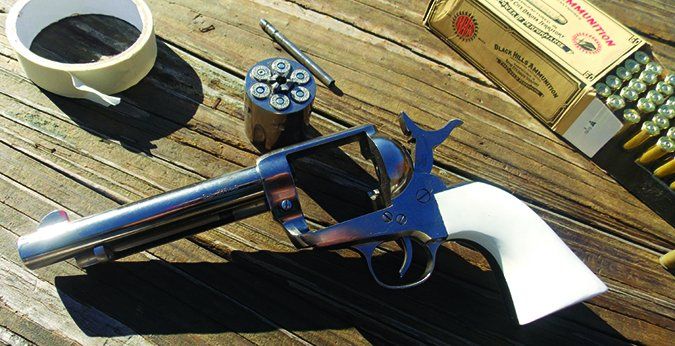
Fired off hand in combat shooting or CAS drills, the 5.5-inch-barrel revolver gave good results, mainly because of the slight extra weight out front and a slightly longer sight radius. With 0.75-inch more sight radius and just over an ounce more weight, the Frontier handled well and gave good results on the firing range. An advantage over a 45 Colt revolver in most types of shooting is that the 357 Magnum revolver weighs more. The Frontier 357 weighs 4 more ounces than a 5.5-inch barrel 45 Colt revolver we had on hand for comparison. After firing the fast-paced drills, we rated the Frontier 5.5-inch barrel superior in all speed drills, although the 4.75-inch barrel was not far behind. The difference, however, was real and verifiable. While the 4.75-inch Gunfighters gun clears leather more quickly and may be handier in a close-range fight, for what we do with single-action revolvers these days, the 5.5-inch barrel is clearly a better offhand shooter.
A problem came when we moved to the full-power Magnum loads. At Gun Tests, all ammunition in a specific category must be from the same lot for consistency. The Frontier revolver was the last test fired for accuracy. The ammunition used was the same type used in the other revolvers without incident. When the hammer fell and the 125-grain 357 Magnum fired, the hammer could not be cocked for another shot. The revolver locked up. At first, the cylinder would not budge. We removed the cylinder pin carefully, taking care not to allow our hands to cross the muzzle. We were able to bump the cylinder out by raising the hammer a bit. The fired cartridge case appeared normal. The primer had not flowed. There were no pressure signs, and the cartridge case slid from the cylinder by simply pushing it out with the cylinder pin. In any case, there was no primer flow to flow back into the firing pin or lock the gun up. An advantage of Magnum revolvers with frame-mounted firing pins is that such a lock-up caused by primer flow is less likely.
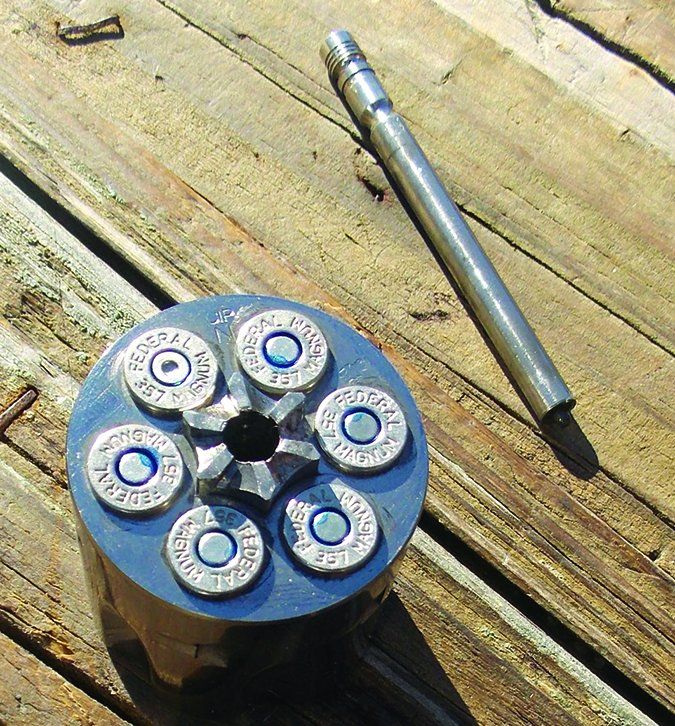
The verdict? This had nothing to do with the ammunition, other than perhaps the harder recoil of the Magnum load. The revolver’s action just locked up on firing. We were able to get the action going by spraying oil in the action and jiggling the hammer. It went back to normal operation. The action, heavily lubricated with FP10, was cycled one hundred times and seemed normal thereafter.
We resumed firing, and the Frontier revolver gave good, if not outstanding, results in accuracy. The Liberty revolver was more accurate. The Sheriff’s Model revolver was less accurate. The Frontier revolver is accurate enough for most chores. During the accuracy test, we painted the front sight with red paint, otherwise the sun glinting on the front sight would have been a serious impediment. This isn’t a demerit if you want a nickel gun.
Our Team Said: We rated the Frontier down based on the action problem and also for tool or polishing marks the other revolvers did not have. The action problem was resolved without much difficulty, but should not have occurred.
We liked all three revolvers for different reasons. If recreation is your game, then the Sheriff’s Model has appeal. But even recreational shooters like to hit the target more often than not, and the Sheriff’s Model isn’t the most accurate revolver of the three. There are folks who purchase handguns based solely on looks, but that isn’t what we do at Gun Tests. The Sheriff’s Model isn’t a bad revolver at all; rather, it is a good revolver less suited to the tasks outlined than the other revolvers. The Frontier revolver with its nickel plate and 5.5-inch barrel will appeal to some shooters and not to others. We did not like the action problem. We did not disassemble and examine the revolver, but you can be certain we will at a later date. We will report on that.
The Liberty 4.75-inch revolver is the Best Buy based on several factors. It is eye catching, and this appearance came cheap, we felt. Performance was excellent. Despite a slight edge in fast snap shooting with the nickel-plated revolver, we feel that with practice, the final outcome would all be decided by the shooter. The Liberty is more accurate than most single-action revolvers despite a trigger action that was the heaviest of any revolver tested. We liked the nickel-plated Frontier, but it is all a matter of taste. The problems with the action soured us on this revolver. Obviously, with two well-performing revolvers from the same maker, it cannot be representative of the factory. We simply chalk it up to our ongoing bad luck. Of all the gun magazines published in the whole world, we seem to get all the malfunctioning guns. But that’s okay, because Gun Tests readers are the beneficiaries.
Written and photographed by Gun Tests staff.
















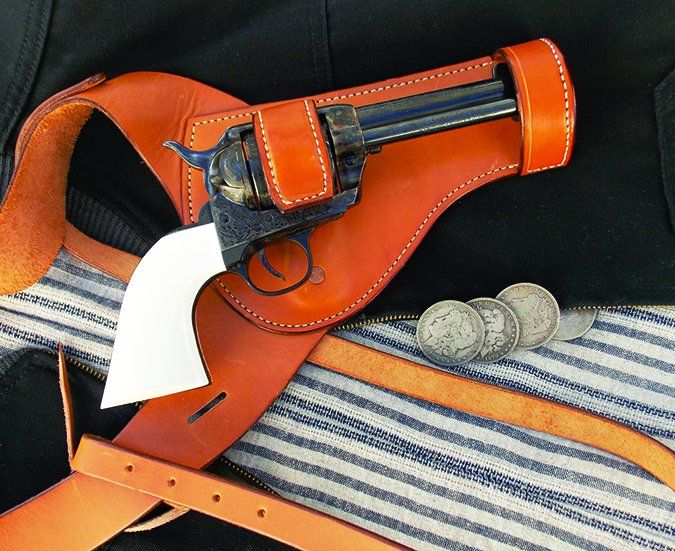



Hi Mr Woodard, I’m looking at buying a 357 mag revolver some time in the future and I would like to know if there are any handling tips I could use to tell one revolver is better than the next.